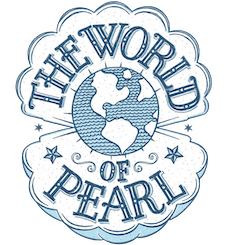
I just got off the phone with a lovely woman, Pilar, in Virginia. She is looking for pearls for her Texas niece’s 18th birthday because she believes, “every Southern girl needs pearls to take to college.” Well, Pilar had a hard time finding the right pearls because she thinks alot of pearls have a grey tint to them. So, she wanted to buy from a great, southern small business (The Pearl Girls) and buy the creamy pearls she knows her niece will enjoy!

This call made me realize that this is a conversation I have had before. A majority of our customers appreciate The Pearl Girls creamy white to warm ivory pearls over pearls with cooler grey tones.
What is the story with those grey tinted pearls?
Well, all colors have three components: hue, tone and saturation. In pearls, the hue is the base color. So, let’s say you call me up and ask for white pearls or black pearls or pink pearls. That is the body color or hue. All pearls also have overtones and undertones and these tones vary considerably. Now, you want the tones, believe me! Without them, pearls really do look flat, due and lifeless. However, tones can change the entire appearance of pearls so you want to choose the right tones based on your preference (or outfit, coloring, etc.) Tones can be cool, in the range of blue or grey, or they can be warm such a peach, ivory or creamy. Guess what we Georgia peaches offer? That’s right! Peach, ivory and creamy overtones!
Here is my quick lesson on pearl tones:
Let’s say it is the middle of winter and you have very pale white legs (I can neither confirm nor deny how pale my legs are!), if you put on stockings that are slightly tan, your pale legs will have a slightly darker over tone. It is a color that does not affect the over-all color but it does affect the tone. It gives them a nice little bit of coloring. That is exactly like the overtone of pearls. Just a nice layer of overall color. Just not as easy to remove as a pair of stockings.
Now, color saturation is how deep, rich and defined the color is. Even if the overtone does not make a pearl look grey, sometimes the lack of color saturation does.
For color saturation, let’s move on to summer. If you spend your entire summer outside, you develop a deep and rich tan. This is like a deep color saturation. Now, when I get in the sun, I like to cover up. So, my tans are usually very shallow and go away quite fast. My tan color is not deeply saturated. With pearls, I look at how much color is in the color (which I realize sounds confusing). On an actual color wheel, desaturated colors fall somewhere along the greyscale. Look at this handy example compliments of NC State. The left side shows the low saturation of red which looks like grey.
 So, saturation means more color in the color where desaturation signifies a color closer to grey. If pearls were not typically so deep in color, they would just be a grey or white tone. Again, as long as no pearls have been harmed or treaded (dyed, irradiated, etc.), these coloring differences are fine. What they usually affect is your judgement and preference more than anything else.
So, saturation means more color in the color where desaturation signifies a color closer to grey. If pearls were not typically so deep in color, they would just be a grey or white tone. Again, as long as no pearls have been harmed or treaded (dyed, irradiated, etc.), these coloring differences are fine. What they usually affect is your judgement and preference more than anything else.
So, long story short, white pearls with a grey tint are a result of either the cool tones or low color saturation. And, which color of pearls is really up to you. Of course, the other take-away here is always take pearls off to college. It pains me to say this but for Pilar’s niece, I will anyway… Hook ’em Horns.
I am a modern day treasure hunter who travels the world for gorgeous pearls and amazing adventures. I own a pearl jewelry and jewelry repair business, ThePearlGirls.com, with a cute retail store in Athens, GA. I also have a Pearl Travel business and travel blog at TheWorldofPearl.com.



